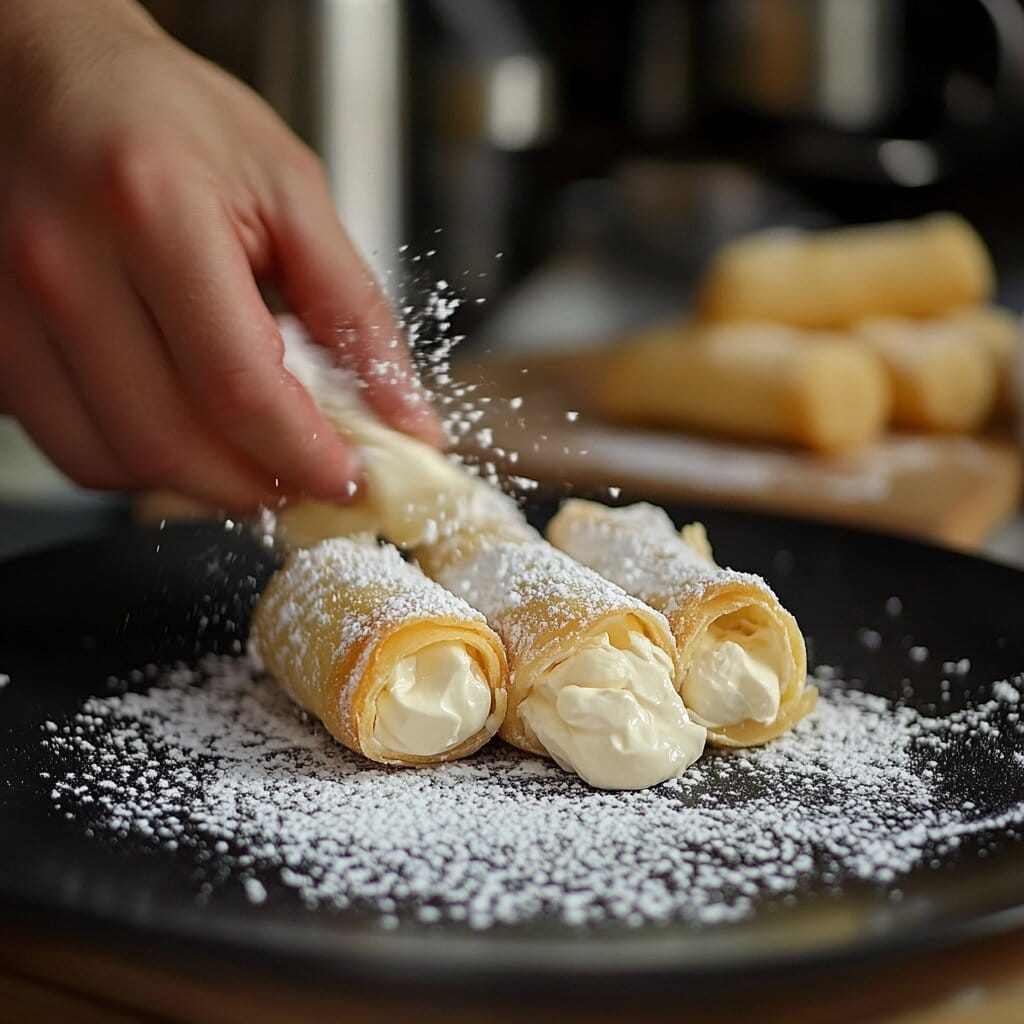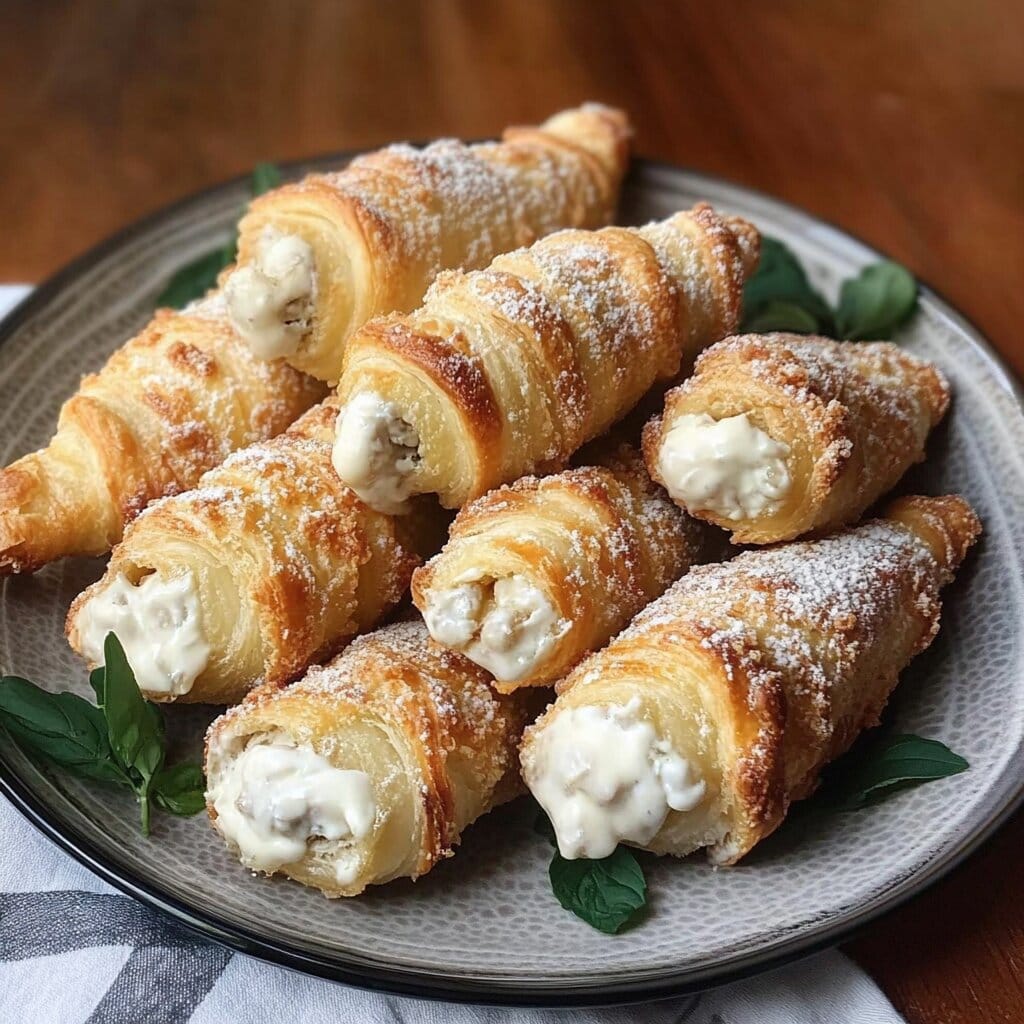Italian Cream Stuffed Cannoncini, often called “little horns”, are a favorite treat among pastry lovers. These golden, flaky delights consist of puff pastry shells filled with a smooth and creamy filling, usually the classic Italian Crema Pasticcera. They are perfect for celebrations, weddings, or even as a simple treat with coffee.

What Are Italian Cream Stuffed Cannoncini ?
Cannoncini are cone-shaped pastries made from crisp puff pastry and filled with rich cream. Unlike cannoli, which use fried dough, Cannoncini rely on the buttery layers of puff pastry. Their distinctive shape and delicious cream fillings make them a standout dessert. In fact, you can easily customize them with different flavors like vanilla, lemon, or chocolate.
The Origin of Cannoncini
Cannoncini originated in northern Italy, especially in regions like Piedmont, where puff pastry and cream desserts were very popular. Over time, bakers perfected this recipe, turning it into a signature Italian dessert. While they began as a luxury for the wealthy, they soon became a favorite treat for people of all backgrounds.
Why Are Cannoncini So Popular?
Cannoncini are so popular because they combine simple ingredients in a beautiful and satisfying way. The crispy pastry contrasts perfectly with the creamy filling, creating a dessert that everyone loves. Moreover, their popularity has grown as Italian food continues to inspire home cooks and professionals around the world. Thanks to their elegance and ease of preparation, Cannoncini are a go-to choice for any special occasion.
The Art of Making Italian Cream Stuffed Cannoncini
Creating Italian Cream Stuffed Cannoncini is a rewarding process that combines the precision of baking with the creativity of flavor crafting. To achieve the perfect Cannoncini, it’s essential to focus on each step, from selecting the ingredients to baking the pastry shells.
Ingredients Overview of Italian Cream Stuffed Cannoncini
Before you begin, gathering the right ingredients is key. For the best results, use high-quality components, as they greatly impact the final taste and texture. Here’s what you need:
- Puff Pastry: A pre-made sheet or homemade dough works perfectly. Look for a brand that ensures multiple, flaky layers.
- Cream Filling: The classic Italian pastry cream, known as Crema Pasticcera, is the most common choice. Variations like chocolate or lemon can add a twist.
- Sugar: Both granulated sugar and powdered sugar are used. The powdered sugar serves as a finishing touch for dusting.
- Eggs: Essential for making the pastry cream and for glazing the puff pastry cones to give them a golden hue.
- Milk: Whole milk is ideal for a rich and smooth cream texture.
- Flavoring: Vanilla extract is traditional, but some recipes include lemon zest, almond essence, or even orange blossom water.
Choosing the Right Puff Pastry
The puff pastry is the foundation of Cannoncini, and choosing the right one makes all the difference. If you’re making it from scratch, ensure the dough remains cold to maintain its flakiness. Store-bought puff pastry is a convenient option, but always look for one made with real butter. The buttery layers create the crisp texture that defines Cannoncini.
For those unfamiliar with handling puff pastry, here are some quick tips:
- Thaw frozen pastry in the refrigerator to prevent it from becoming too soft.
- Use a sharp knife or pizza cutter to ensure clean cuts when shaping the pastry.
- Keep a light dusting of flour on your work surface to prevent sticking.
Importance of Fresh Ingredients
Fresh ingredients elevate any dessert, and Cannoncini are no exception. When you use fresh milk, eggs, and butter, the difference is noticeable in both taste and texture. Additionally, freshly grated lemon zest or vanilla beans can make your cream filling stand out. Avoid artificial flavorings or stale pantry items, as they can compromise the quality of your pastries.

Preparation is Key
Preparation is crucial when making Cannoncini. Since the puff pastry must be shaped into cones, plan ahead by ensuring you have the right tools. Stainless steel or silicone cone molds are widely available and make the process easier. For a more rustic look, you can roll the pastry into free-form cones, but molds help create uniform shapes.
Make sure to prepare your filling in advance. The cream needs time to cool before you pipe it into the pastry, so it’s best to have it ready before baking.
Preparing the Perfect Cream Filling
The cream filling is the heart of Italian Cream Stuffed Cannoncini. While the puff pastry provides the structure, the filling adds flavor and texture, making these pastries truly irresistible. A classic Crema Pasticcera is the most traditional choice, but you can explore other variations to suit your taste.
Types of Cream Fillings
Cannoncini fillings can range from the traditional to the experimental. Here are a few common options:
- Classic Italian Pastry Cream (Crema Pasticcera): This custard-like filling is made with milk, sugar, egg yolks, and cornstarch, flavored with vanilla. It’s smooth, rich, and slightly thick—perfect for piping.
- Chocolate Cream: By adding melted chocolate or cocoa powder to the pastry cream, you can create a decadent chocolate filling.
- Lemon Cream: This filling uses lemon zest and juice, giving the Cannoncini a fresh, zesty flavor.
- Mascarpone Cream: Combining mascarpone cheese with sugar and vanilla creates a luxurious, creamy texture with a slight tang.
How to Make Crema Pasticcera
Crema Pasticcera is the most popular filling for Cannoncini. It’s not only delicious but also versatile, pairing beautifully with the crispy pastry. Here’s how to make it:
Ingredients:
- 2 cups whole milk
- 4 egg yolks
- ½ cup granulated sugar
- 3 tablespoons cornstarch
- 1 teaspoon vanilla extract (or the seeds of 1 vanilla bean)
Instructions:
- Heat the Milk: In a medium saucepan, heat the milk over medium heat until it begins to steam. If using a vanilla bean, split it and scrape the seeds into the milk, then add the pod. Remove from heat and let it infuse for 5–10 minutes.
- Whisk the Yolks: In a mixing bowl, whisk the egg yolks and sugar until the mixture becomes pale and creamy. Add the cornstarch and mix until smooth.
- Temper the Eggs: Slowly pour the warm milk into the egg mixture, whisking constantly to prevent the eggs from curdling.
- Cook the Cream: Pour the mixture back into the saucepan and cook over low heat, stirring constantly. The cream will thicken as it cooks. Once it reaches a custard-like consistency, remove from heat.
- Add Vanilla: If using vanilla extract, stir it in now. Strain the cream through a fine mesh sieve for extra smoothness.
- Cool the Cream: Transfer the cream to a bowl, cover it with plastic wrap (pressing it directly onto the surface to prevent a skin from forming), and let it cool completely.

Tips for Perfecting the Cream
Making the perfect cream filling takes practice, but these tips will help you achieve a flawless result:
- Avoid Lumps: Stir the cream constantly while it cooks to prevent lumps. Using a whisk instead of a spoon can help.
- Prevent a Skin: Always cover the cream with plastic wrap that touches the surface. This prevents a hard layer from forming as it cools.
- Chill Before Piping: Make sure the cream is completely cool before filling the Cannoncini. Warm cream can make the pastry soggy.
- Enhance the Flavor: Add a splash of your favorite liqueur, like limoncello or amaretto, for a sophisticated twist.
Creating the Cream Filling for Italian Cream Stuffed Cannoncini
If you want to experiment, try mixing in different flavors or ingredients:
- Nutty Twist: Add finely ground hazelnuts or almonds to the pastry cream for a nutty flavor.
- Spices: A hint of cinnamon or nutmeg can add warmth to the cream.
- Fruit Puree: Swirl in a bit of fruit puree, like raspberry or mango, for a fruity variation.
Assembling and Baking Italian Cream Stuffed Cannoncini
Now that you’ve prepared your cream filling, it’s time to focus on crafting the puff pastry cones and assembling your Cannoncini. This step requires a combination of patience and technique to ensure perfectly baked, golden pastries.
Forming the Puff Pastry Cones
The first step in assembling Cannoncini is shaping the puff pastry into cones. While this might seem tricky at first, the process becomes much easier with the right tools and a few key tips.
- Roll Out the Dough: Begin by rolling out your puff pastry on a lightly floured surface. Make sure the dough is even and not too thick, as this will help the cones bake evenly.
- Cut the Strips: Using a sharp knife or a pizza cutter, slice the dough into long strips, about 1 inch wide. Try to keep the width consistent to ensure a uniform appearance.
- Wrap the Strips: Starting from the tip of your cone mold, wrap a strip of pastry around the mold, overlapping slightly with each turn. Make sure there are no gaps, as these could affect the cone’s structure.
- Seal the Edges: Press the end of the strip gently onto the pastry to secure it. This ensures the cone won’t unravel during baking.
To make things easier, you can lightly grease the molds or line them with parchment paper, so the pastry slides off easily after baking.
Baking Tips for Golden Perfection
Once the pastry cones are ready, baking them correctly is crucial to achieving the crisp, flaky texture that defines Cannoncini. Here are some tips to guide you:
- Preheat the Oven: Always preheat your oven to 375°F (190°C) before baking. This ensures the pastry cooks evenly and develops a golden-brown color.
- Glaze for Shine: Lightly brush the pastry with an egg wash (a mix of beaten egg and a splash of water or milk). This not only enhances the appearance but also adds a subtle crispness.
- Bake on a Wire Rack: Place the molds on a wire rack or a parchment-lined baking sheet. This prevents the bottom of the pastry from becoming too soft.
- Monitor Closely: Check the cones as they bake, and rotate the tray if necessary for even browning. The cones typically take 15–20 minutes to bake.
Once baked, let the cones cool for a few minutes before carefully removing the molds. Be gentle, as the pastry can be fragile.
Filling Techniques
After the cones have cooled completely, it’s time to fill them with the cream. This is where your hard work comes together, so take your time and follow these tips for the best results:
- Use a Piping Bag: A piping bag fitted with a star or plain tip works best for filling Cannoncini. This tool allows you to fill the cones neatly and evenly.
- Fill from the Bottom Up: Begin at the narrow end of the cone and pipe the cream slowly, moving toward the wider opening. This method ensures the filling is distributed evenly.
- Add Decorative Touches: To elevate the presentation, consider dusting the filled cones with powdered sugar or drizzling them with melted chocolate. Crushed nuts, such as pistachios or almonds, can also be sprinkled on top for added texture.
Avoiding Common Mistakes
Even experienced bakers encounter challenges when making Cannoncini. Here are some common mistakes and how to avoid them:
- Gaps in the Pastry: If the dough isn’t wrapped tightly enough, the cones can lose their shape. Wrapping with slight overlap prevents this issue.
- Soggy Pastry: Always allow the cones to cool completely before filling them with cream. Warm pastry can soften quickly when combined with the cream.
- Overfilling: While it’s tempting to add extra cream, overfilling can cause the pastry to crack or become messy. Pipe just enough to reach the edges of the cone.
Serving and Storing Italian Cream Stuffed Cannoncini
Once your Italian Cream Stuffed Cannoncini are assembled and filled, it’s time to focus on presentation and storage. These delightful pastries not only taste heavenly but also look stunning when served with care. Moreover, proper storage ensures their freshness, allowing you to enjoy them even after a day or two.
Presentation Tips
The way you present Cannoncini can elevate them from a simple dessert to a show-stopping centerpiece. Here are some ideas to make your pastries look as delightful as they taste:
- Arrange on a Tiered Stand: A tiered pastry stand adds height and elegance to your display, making it perfect for parties or special occasions.
- Add a Dusting of Powdered Sugar: Lightly dust the filled Cannoncini with powdered sugar just before serving. This not only enhances their appearance but also adds a touch of sweetness.
- Decorative Garnishes: Sprinkle the tips of the filled cones with crushed nuts, shredded coconut, or edible flowers for a polished look.
- Pair with Fresh Fruits: Arrange sliced strawberries, raspberries, or a few mint leaves around the plate for a pop of color.
- Serve with Coffee or Tea: A cup of espresso, cappuccino, or even a delicate herbal tea complements the richness of the cream filling beautifully.
Storing for Freshness
Cannoncini are best enjoyed fresh, as the crisp pastry and creamy filling create a perfect texture contrast. However, with the proper storage techniques, you can keep them tasting delicious for a little longer. Here’s how:
- Store Unfilled Pastry Separately: If you plan to make Cannoncini in advance, bake the pastry cones ahead of time and store them in an airtight container at room temperature. Fill them just before serving to maintain their crispness.
- Refrigerate Filled Cannoncini: If your Cannoncini are already filled, store them in the refrigerator in a single layer to prevent them from becoming soggy. Place a sheet of parchment paper between layers if you need to stack them.
- Use Within 1–2 Days: For the best texture and flavor, consume filled Cannoncini within 1–2 days. After this time, the pastry may lose its crunch, and the cream could separate slightly.
- Avoid Freezing: While you can freeze unbaked puff pastry, baked and filled Cannoncini don’t freeze well. The pastry becomes soft, and the cream’s texture changes when thawed.
Pairing Suggestions of Italian Cream Stuffed Cannoncini
Pairing Cannoncini with complementary drinks or accompaniments can enhance the overall experience. Here are a few ideas to consider:
- Espresso or Cappuccino: The bitterness of coffee balances the sweetness of the cream, creating a classic Italian pairing.
- Dessert Wine: A glass of sweet Italian wine, like Moscato d’Asti, pairs beautifully with the rich flavors of Cannoncini.
- Fresh Fruit: Serve Cannoncini alongside a fruit platter for a refreshing contrast. The tartness of berries complements the creamy filling.
- Gelato or Sorbet: For an indulgent treat, pair the pastries with a scoop of vanilla gelato or a citrusy sorbet.
Adding a Modern Twist
If you want to impress your guests, consider experimenting with creative ways to serve Cannoncini:
- Mini Cannoncini: Create bite-sized versions of the pastry for a more manageable dessert option.
- Themed Decorations: Decorate the pastries to match a party theme, such as using colored dusting sugar or edible glitter.
- Flavored Cones: Add a layer of melted chocolate or caramel to the inside of the pastry cones before filling them. This adds flavor and prevents the pastry from softening too quickly
Frequently Asked Questions
What’s the difference between a cannoli and a cannoncini?
Although both are Italian pastries, they differ in preparation and structure. Cannoli are made from fried pastry shells filled with a ricotta-based cream, often flavored with chocolate or citrus. Cannoncini, on the other hand, use baked puff pastry cones filled with smooth pastry cream (Crema Pasticcera) or other variations. Cannoli are typically associated with Sicily, while Cannoncini have roots in northern Italy.
What is Cannoncini in English?
In English, Cannoncini translates to “little horns.” The name reflects their signature horn-like shape, formed by wrapping puff pastry into a cone.
What is Italian Cream Stuffed Cannoncini made of?
Traditional Italian cream, or Crema Pasticcera, consists of simple ingredients: milk, egg yolks, sugar, and cornstarch. Vanilla or lemon zest is often added for flavor. This smooth and thick custard is a staple in Italian desserts like Cannoncini, tarts, and cakes.
What is the cream in cream horns made of?
The cream used in cream horns is often a sweetened whipped cream or buttercream, which gives them a light and airy texture. However, Cannoncini, their Italian counterpart, are typically filled with rich pastry cream for a denser and more indulgent filling.
Conclusion
Italian Cream Stuffed Cannoncini embody the magic of Italian baking—combining crisp, buttery puff pastry with rich, velvety cream. Whether you stick to the traditional Crema Pasticcera filling or experiment with modern variations, these pastries never fail to impress. Their versatility, elegance, and delightful flavor make them a perfect choice for any occasion, from casual gatherings to grand celebrations.
By following this guide, you’ve learned the essential techniques and tips to create your own batch of Cannoncini. From shaping the cones to perfecting the cream filling, every step brings you closer to mastering this iconic dessert. So, gather your ingredients, preheat your oven, and start crafting a treat that captures the heart of Italian cuisine. Buon appetito!

